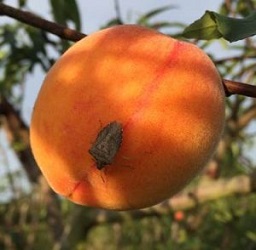Article from
VSCNews, Vegetable and Specialty Crop News
by Breanna Kendrick
Managing Stink Bugs on Peaches

At
the recent Stone Fruit Field Day, Cory Penca gave a presentation on
managing key pests of peaches in Florida. Penca is an entomology Ph.D.
candidate and a student in the Doctor of Plant Medicine program at the
University of Florida. His presentation covered stink bugs, Caribbean
fruit flies, plum curculio and mites. Penca’s pest management
practices have been developed during his research in three seasons of
field work.
According to Penca, stink bugs can be difficult to
manage, and it doesn’t take a lot of them to cause crop losses. During
the spring when the peach crop is beginning to develop, stink bugs are
hunting for a food source, and peaches are one of the ideal crops for
the pest to feed on. Stink bugs come from outside the orchard and stab
the fruit as it is developing. The stabbing damage will develop into an
injury called cat-facing, in which the fruit expands slower at the
point where it was fed on. At the feeding point, the peach becomes
folded because the cells there cannot expand.
Pests like stink
bugs can be monitored with a yellow pyramid trap design with a
pheromone lure applied to it. “It’s a really good method because it
tells you about the stink bug population in the entire area around the
orchard, and you can even find information about the stink bug
population before the fruit has developed,” said Penca. “It gives you
an idea early on if you have a population of stink bugs already present
as soon as January or February. From my data, I’ve found in some
locations that stink bugs, at relatively high levels, are present
before the fruit has even passed the petal fall stage (this means when
the flower is still on the tree, but not fruit). So, they’re obviously
feeding on something else in the area and then switch over to the
peaches when they are available.”
Penca said a low number of
stink bugs could cause problems, but the pest is hard to find at low
levels. Also, depending on the time of day and the conditions, stink
bugs might not be as present, so growers might underestimate their
problem. He said finding just one or two stink bugs could imply a high
population of the pest. “Often, when you are looking, you will find no
stink bugs at any given time; this does not mean you don’t have a stink
bug problem,” Penca advised.
Cory
Penca is an entomology Ph.D. candidate and a student in the
Doctor of Plant Medicine program at the University of Florida.
|
|
